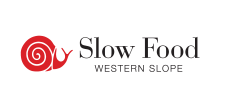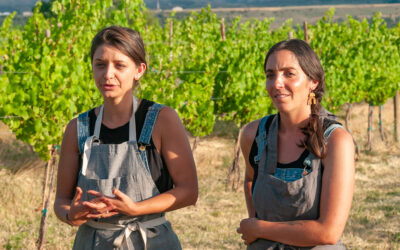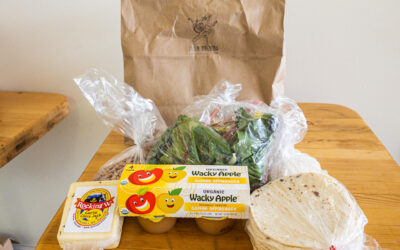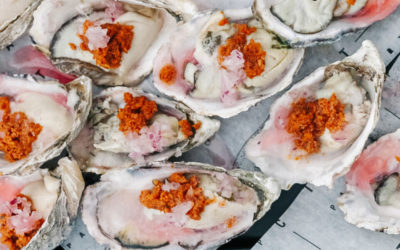From the the North Fork Merchant Herald, March 18, 2014
North Fork Foods: A Cottage Foods, On-the Farm Bakery: There is the baking and then there is the organizing
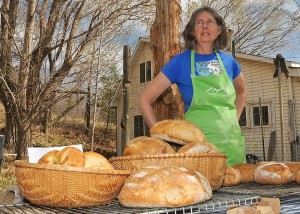 Written by Monica Wiitanen
Written by Monica Wiitanen
Two years ago when the Colorado Cottage Foods bill was working its way through the Colorado Legislature, my focus was on testimony, votes, and keeping in touch with a network of supporters around the state. Soon after the bill was signed into law, Yohann and I took a Safe Food Handling class, as required, and began selling bread. The law requires labels, and Wayne had come up with a sample prior to signing.
Late in March 2012 we began to provide the bread that our produce customers had been asking for. Breads, labels, bags, twisties—and we were off! It’s been quite an adventure!
Other than planning to bake on Fridays, when customers came to the farm already, I hadn’t really thought about the future. I was just thrilled that Colorado allowed residents to make certain low risk foods in their home kitchens and sell those products directly to their customers.
It never entered my mind how the bakery would grow, how new customers would hear about our breads from friends, and how much work there would be just keeping recipes, signs, and even those labels organized! With over forty kinds of breads and more than 60 treats having been made these two years, there are a lot of paper pieces to keep track of.
A retained heat oven like mine bakes best when loaves fill the hearth, so while recipes may come from books; the batch needs to be sized for my oven. I hand write the recipes and make notes of container sizes (for dry mixes, for soakers, sourdoughs, and pre-ferments) and also of any changes made to the dough. Does this dough always need a little more water or flour at our altitude? Is it quicker to rise than the recipe indicates? Capturing these comments on the recipe makes the next time a little easier.
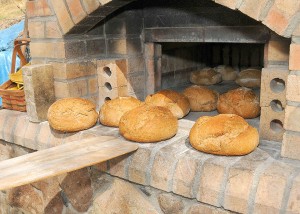 Since baking in this oven is governed by temperature, starting above 500° and working down to 325° and even lower, I had already worked out a colored card system. I wrote recipes on red cards for anything that preferred 500° or more, like pizza, socca, and polenta, orange cards for sourdoughs, soda breads, and scones that baked best in the 450° to 500° range, yellow for yeasted breads and treats that prefer the 400° to 450° range, green (350° to 400°) for sweet doughs, bars, and some cookies, and blue (300° to 350°) for cookies, Blitz Kuchen, and oatcakes that do best at these lower temperatures.
Since baking in this oven is governed by temperature, starting above 500° and working down to 325° and even lower, I had already worked out a colored card system. I wrote recipes on red cards for anything that preferred 500° or more, like pizza, socca, and polenta, orange cards for sourdoughs, soda breads, and scones that baked best in the 450° to 500° range, yellow for yeasted breads and treats that prefer the 400° to 450° range, green (350° to 400°) for sweet doughs, bars, and some cookies, and blue (300° to 350°) for cookies, Blitz Kuchen, and oatcakes that do best at these lower temperatures.
Having worked out the colors and cards, it was a quick step to colored binders in which to put the recipes. Labels were put in small plastic bags and filed in plastic tubs. Signs (enlarged labels to start with) were put into binders for breads, for treats, and for gluten-free items. This “system” was put into place over time, but it meant looking in three different places to get everything needed for each product we planned to make, and putting those three things back into three different places. The signs were in clear sleeves. What if the labels were slipped into the back of the sleeves and the recipe, sign, and labels were put together into the appropriate colored binder?
The next step has been to organize the binders to make planning easier. Each week I strive to make a “light” sourdough (light referring to the color of the crumb, so with a small percentage of whole grain flours), a rye sourdough, and a whole wheat loaf, sometimes sourdough, sometimes yeasted. Usually there’s something that can take extra high heat, like fougasses, bagels, or baguettes. Sections of the binders now hold the recipes used for each of these categories, which reduces search time. Seasonal recipes have been moved into a separate binder entirely. When it’s time to make Hot Cross Buns I’ll be able to go right to the recipe! When time allows some kind of a treat is added to the plan, as well as something gluten-free—at the end of a long Bake Day I like to have something to eat, too. Lately I’ve been baking with nut and seed flours, which are naturally gluten-free. By using stevia when sweetening is called for, these products have very low levels of carbohydrates and have little if any effect on blood sugar levels.
Like a traveler with new places to explore, I find myself pulled in the direction of big, traditional sourdough loaves made with 4 to 5 pounds of dough per loaf. Ancient grains (spelt, emmer, and einkorn) are on the horizon—actually spelt is in the pantry awaiting a slot on a future Bake Day.
This adventure began before the oven was built. I realized that it would benefit small farms to be able to use excess and injured produce to make value-added products that could augment the farm income. I discovered that Kentucky had passed such a bill in 2003. I showed up whenever Senator Schwartz was in Delta County. One thing led to the next and there I was in Denver two years ago when the bill was signed into law. Being involved in the process made me feel a full-fledged member of my family.
A wood-fired oven, a law that allows me to sell what I bake, and people to interact with—bakers, helpers, customers—life is full!
